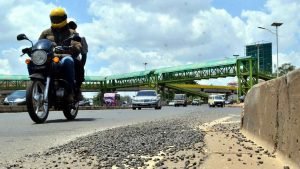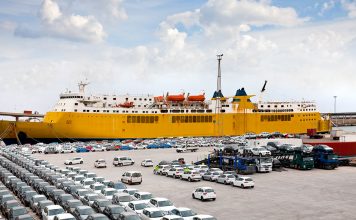It was meant to be a superhighway zooming city residents to the future.
With a price tag of Sh32 billion, the Nairobi-Thika road, the first of its kind in Kenya, lived up to the billing.
That was, however, until late last year when the Kenya National Highways Authority (KeNHA) started recarpeting the service lanes, before eventually moving to the express lanes.
Since then, motorists using Thika Road have been having hard times and thanking lady luck after getting home safely.
KeNHA says it embarked on surface dressing of the road to slow down its deterioration.
“The rapid speed of the process means that disruption to road users, local businesses and emergency services is minimised,” KeNHA says.
The authority said the surface dressing is done to protect the road from wear and tear as the bituminous film acts as a waterproof seal, preventing the entry of surface water into the road structure.
The stone chippings protect the film from damage by vehicle tyres something that the durability of the road.
“Surface dressing is preventative for roads that are in relatively good condition. It can last around 10 years. Roads can be re-dressed up to three times, and it is very cost-effective. Also, the work is done relatively quickly,” KeNHA adds.
KeNHA further says this should be done where minimum road surface temperature is 25-30 degrees Celsius, which means it can only be done during the day.
“This will usually be done after 24 hours, but during hot weather, this may take longer. The bitumen is thereafter allowed to set for a period of seven to 10 days before road marking can be initiated.”
Drivers are also advised to keep to the temporary low-speed limits and avoid sharp turns. This allows the surface to stabilise and also prevents any damage to the vehicle.
Despite this explanation, motorists say KeNHA did not inform them of the dangers they might face with some reporting damage to their vehicles from the chippings. Others had their windscreens damaged.
Downgrading the aesthetic value
Those who spoke to the Nation were of the view that the contractor was downgrading the aesthetic value of the original multi-billion-shilling highway.
“The contractor has been doing a shoddy job, with tarmac being washed away by rains immediately after re-carpeting and at the same time leaving a lot of loose chippings, making it unsafe for motorists,” said Gordon Ochieng, a victim of the loose chippings who had his windscreen shattered.
Amos Olako, a mechanic who operates along the busy highway, said they had seen an increase in people coming to have their windscreens replaced in the last few months, with the majority blaming the loose chips on the road.
“Normally we would see two or three customers coming to have their windscreens replaced in a month, but now we see the same number of customers in a week,” he said.
A spot check by the Nation on the highway revealed chippings left loose for weeks, no marking to warn the road users, and in some sections of the road, the newly-replaced tarmac had already peeled off days after it was done.
Also, some sections have had the lanes marked with the loose chippings still evident.
One of the sections that have seen the newly laid tarmac peel off is the Pangani stretch. By the time of publishing this story, the Pangani stretch also remained unmarked leaving motorists to guess the lanes.

Other sections, especially the service lanes, have suffered the most damage.
“The surface dressing is poorly done. The standard of work should be benchmarked against international standards,” complained a motorist who declined to give his name.
“The ruining of Thika Superhighway is almost complete.”
According to standards, following the redressing of the carriageway, the road should be swept clean as loose chippings are also dangerous to motorcyclists as it gets channelled into dangerous accumulations on the edges of the road.
“The chippings at the edges remain loose and dangerous,” Charles Kimeu, a cyclist who uses the highway every day, said.
But KeNHA, through its Assistant Director of Corporate Communications Charles Njogu, disputed the claims, saying their work was up to quality. He dismissed those claiming KeNHA was doing a shoddy job.
“I can tell you we sweep the road soon after it has been tarmacked. We do not leave any loose chippings on the road and no one should blame us for any accidents that may happen as a result of the state of the road,” he said.
The road works have been blamed for deaths and accidents on the busy superhighway.
In one of the incidents, a man blamed the loose chippings for leaving him a widower at the age of 24.
Faustine Lipuku Lukale blamed the death of his wife Milka Mumbi, 22, on the loose chippings.
According to Mr Lukale, he was driving towards the Kenyatta University footbridge when he suddenly saw a stalled car. As he approached it, he tried to brake but the brakes failed.
SOURCE: https://nairobinews.nation.co.ke/news/is-this-the-ruining-of-thika-superhighway



![Top 20 Used Cars to Avoid Buying in Kenya – [PHOTOS]](../../../blog/wp-content/uploads/2013/11/top-used-unreliable-cars-to-avoid2-80x60.jpg)

![Top 20 Used Cars to Avoid Buying in Kenya – [PHOTOS]](../../../blog/wp-content/uploads/2013/11/top-used-unreliable-cars-to-avoid2-100x70.jpg)



